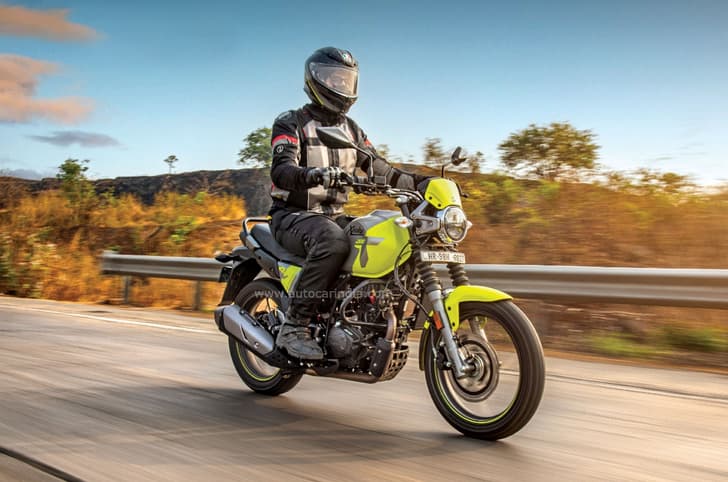if you wanted a mid-capacity, air-cooled, single-cylinder retro motorcycle, your options consisted of the Benelli Imperiale 400, Honda CB350s and the Royal Enfields. New to India but not new to motorcycles, Chinese giant QJMotor is now aiming for a slice of that pie with the visually familiar SRC 500.
Design and build
I’ve had the chance to observe both the Imperiale and the SRC side by side and while the QJ is visually very similar to the Benelli, it is a noticeably larger and heftier motorcycle. In fact, the SRC’s 1,440mm wheelbase is even longer than an Interceptor 650, by a significant 42mm. In the flesh, this is a very appealing bike; from its retro two-tone bodywork to the generous use of chrome in the rider’s field of view, I very much like the way this bike looks. The paint quality is good, but this particular white/red colourway isn’t the easiest to keep clean in our conditions.
.jpg?w=700&c=0)
The retro theme is reinforced by halogen bulbs all around and the headlight does a good job of illuminating the road in the dark. The SRC’s fully digital twin-pod display is well laid out and displays relevant data, but I believe that the Imperiale’s digi-analogue set-up would have suited the QJ’s retro character more.
Quality is a bit of a letdown with a few eyesores on this otherwise handsome machine. Multitudes of wires, cables, hoses and whatnot are visible in plain sight, the rider’s footrest is bolted on via a very crude-looking metal bracket, and the pass switch is pressed every time you fully pull in the clutch lever (something we also faced on the Keeway V302C).
.jpg?w=700&c=0)
However, all of these complaints pale in comparison to this one. There is virtually no gap between the chain and the left ‘leg’ of the centre stand resulting in a very alarming and loud clanking sound as the chain smacks against it when the engine is under load. This happens due to an issue with the main stand bracket design and it cannot be good in the long run for either the chain or the stand. The company says that it is working on a solution.
At 205 kg, the SRC 500 is hefty (10kg more than a Classic 350), and you feel the weight at slow speeds or while moving it around. The weight is also an issue while taking tight U-turns due to its large turning radius. Once you get moving, however, it does get better but you have to be mindful that this is a wide and long bike. While its 800mm seat height figure seems approachable, it’s a bit wide where the tank meets the seat, which splays your legs out a bit. At 5’11”, it wasn’t a big issue for me, but shorter riders will be affected by this. On the other hand, taller riders may also find the seat height to be slightly low in relation to the foot pegs. Overall, the riding position is relaxed with your upper body nearly straight and your feet placed neutrally, which is conducive to spending long hours in the saddle.
Performance and handling
Plonked in the rather old-school double-cradle frame is a large but simple two-valve, air-cooled, 480cc, single-cylinder mill that’s rated for 25.5hp and 36Nm. While these figures aren’t exactly impressive on paper for a near-500cc bike, the SRC is quicker than the Benelli Imperiale to 100kph by nearly 5s. It can also easily hold triple-digit cruising speeds all day long, with minimal vibrations, helped by its tall gearing.
In our time with it, the SRC 500 achieved a respectable 33.3kpl (overall), which, combined with its 15.5-litre fuel tank means it can comfortably cover more than 450km on a single tankful. The gearbox is a 5-speed unit and my complaint with it is that there’s a disproportionately large gap between the foot peg and gear lever, resulting in you having to exaggerate your foot movement every time you need to shift gears. This wouldn’t have been such a big issue if there was a heel-shifter, something you’d expect on a laidback machine.
.jpg?w=700&c=0)
What dissuades you from holding the aforementioned cruising speeds, however, are the weak, spongy brakes. There’s very little feedback available and stopping power is just about adequate. Then there’s the stock suspension set-up, which is far too soft, with the twin rear shocks bottoming out quite easily over most bumps. Adding two clicks of preload at the rear helped, (I weigh close to 86kg with gear), but the overall feel from the suspension isn’t one of well controlled damping. And as has been the case with all the Chinese bikes we’ve tested recently, the SRC’s ABS calibration is too sensitive and the accelerator’s travel is abnormally long.
Should you buy one?
Despite all the flaws listed above, in the week I’ve spent riding the QJ SRC 500, I’ve come to really like it. That torquey engine is the star of the show for me and the retro design is a visual treat. However, the quality levels are disappointing for a Rs 2.8 lakh bike, and there are quite a few teething issues that need to be addressed.
.jpg?w=700&c=0)
The biggest thorn, however, is that for just Rs 23,000 more, you could get yourself the Royal Enfield Interceptor 650, which is a marked cut above in terms of performance, quality as well as desirability. Not to mention Royal Enfield’s expansive sales and service network. If QJMotor wants to prove itself as a viable alternative to the established brands, it’s got some ground to cover.




































